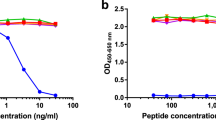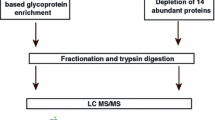Abstract
Inspection of patient-derived cells used in transplantation is non-invasive. Therefore, proteomics analysis using supernatants of cells cultured before transplantation is informative. In order to investigate the cell niche of bovine periosteal cells, supernatants of these cultured cells were subjected to 2-D electrophoresis followed by mass spectrometry, which identified type 1 collagen and the C-terminus of type 3 collagen. Only the C-terminal peptide from type 3 collagen was found in supernatants. It is known that type 3 collagen may be expressed intra- or extra-cellularly. Paraffin sections of the cultured cells were next examined by immunohistochemistry, which revealed that type 3 collagen regions besides the C-terminal peptide were present around the bovine periosteal cells but were not found in supernatants. Full-length type 3 collagen was closely associated with the cells, and only the C-terminal peptide was detectable in culture supernatants. Mass spectrometry analysis of partial peptide data combined with immunohistochemistry also indicated that uveal autoantigen with coiled coil domains and ankyrin repeats (UACA), exosome complex component RRP45 (EXOSC9), and thioredoxin-related transmembrane protein 2 (TMX2) were expressed in bovine periosteal cells. Results of this study indicate that analysis of culture supernatants before cell transplantation can provide useful biomarkers indicating the niche of cells used for transplantation.





Similar content being viewed by others
References
Akiyama M, Nonomura H, Kamil SH, Ignotz RA (2006) Periosteal cell pellet culture system: a new technique for bone engineering. Cell Transplant 15(6):521–532
Akiyama M, Nakamura M (2009) Bone regeneration and neovascularization processes in a pellet culture system for periosteal cells. Cell Transplant 18(4):443–452
Yamada K, Senju S, Nakatsura T, Murata Y, Ishihara M, Nakamura S, Ohno S, Negi A, Nishimura Y (2001) Identification of a novel autoantigen UACA in patients with panuveitis. Biochem Biophys Res Commun 280(4):1169–1176
Ohkura T, Taniguchi S, Yamada K, Nishio N, Okamura T, Yoshida A, Kamijou K, Fukata S, Kuma K, Inoue Y, Hisatome I, Senju S, Nishimura Y, Shigemasa C (2004) Detection of the novel autoantibody (anti-UACA antibody) in patients with Graves’ disease. Biochem Biophys Res Commun 321(2):432–440
Moravcikova E, Krepela E, Prochazka J, Rousalova I, Cermak J, Benkova K (2012) Down-regulated expression of apoptosis-associated genes APIP and UACA in non-small cell lung carcinoma. Int J Oncol 40(6):2111–2121
Tran NH, Sakai T, Kim SM, Fukui K (2010) NF-kappaB regulates the expression of Nucling, a novel apoptosis regulator, with involvement of proteasome and caspase for its degradation. J Biochem 148(5):573–580
Kim SM, Sakai T, Dang HV, Tran NH, Ono K, Ishimura K, Fukui K (2013) Nucling, a novel protein associated with NF-kappaB, regulates endotoxin-induced apoptosis in vivo. J Biochem 153(1):93–101
Mistry DS, Chen Y, Sen GL (2012) Progenitor function in self-renewing human epidermis is maintained by the exosome. Cell Stem Cell 11(1):127–135
Roh SG, Kuno M, Hishikawa D, Hong YH, Katoh K, Obara Y, Hidari H, Sasaki S (2007) Identification of differentially expressed transcripts in bovine rumen and abomasum using a differential display method. J Anim Sci 85(2):395–403
Yoshihara E, Chen Z, Matsuo Y, Masutani H, Yodoi J (2010) Thiol redox transitions by thioredoxin and thioredoxin-binding protein-2 in cell signaling. Methods Enzymol 474:67–82
Kinoshita E, Kinoshita-Kikuta E, Takiyama K, Koike T (2006) Phosphate-binding tag, a new tool to visualize phosphorylated proteins. Mol Cell Proteomics 5(4):749–757
Gurkan UA, Kishore V, Condon KW, Bellido TM, Akkus O (2011) A scaffold-free multicellular three-dimensional in vitro model of osteogenesis. Calcif Tissue Int 88(5):388–401
Ma D, Yao H, Tian W, Chen F, Liu Y, Mao T, Ren L (2011) Enhancing bone formation by transplantation of a scaffold-free tissue-engineered periosteum in a rabbit model. Clin Oral Implants Res 22(10):1193–1199
Hildebrandt C, Buth H, Thielecke H (2011) A scaffold-free in vitro model for osteogenesis of human mesenchymal stem cells. Tissue Cell 43(2):91–100
Horiuchi K, Amizuka N, Takeshita S, Takamatsu H, Katsuura M, Ozawa H, Toyama Y, Bonewald LF, Kudo A (1999) Identification and characterization of a novel protein, periostin, with restricted expression to periosteum and periodontal ligament and increased expression by transforming growth factor beta. J Bone Miner Res 14(7):1239–1249
Fortunati D, Reppe S, Fjeldheim AK, Nielsen M, Gautvik VT, Gautvik KM (2010) Periostin is a collagen associated bone matrix protein regulated by parathyroid hormone. Matrix Biol 29(7):594–601
Bandyopadhyay A, Kubilus JK, Crochiere ML, Linsenmayer TF, Tabin CJ (2008) Identification of unique molecular subdomains in the perichondrium and periosteum and their role in regulating gene expression in the underlying chondrocytes. Dev Biol 321(1):162–174
Graneli C, Thorfve A, Ruetschi U, Brisby H, Thomsen P, Lindahl A, Karlsson C (2014) Novel markers of osteogenic and adipogenic differentiation of human bone marrow stromal cells identified using a quantitative proteomics approach. Stem Cell Res 12(1):153–165
Tour G, Wendel M, Tcacencu I (2013) Human fibroblast-derived extracellular matrix constructs for bone tissue engineering applications. J Biomed Mater Res A 101(10):2826–2837
Pivodova V, Frankova J, Ulrichova J (2011) Osteoblast and gingival fibroblast markers in dental implant studies. Biomed Pap Med Fac Univ Palacky Olomouc Czech Repub 155(2):109–116
Miller MH, Ferguson MA, Dillon JF (2011) Systematic review of performance of non-invasive biomarkers in the evaluation of non-alcoholic fatty liver disease. Liver Int 31(4):461–473
Srivastava M, Eidelman O, Torosyan Y, Jozwik C, Mannon RB, Pollard HB (2011) Elevated expression levels of ANXA11, integrins beta3 and alpha3, and TNF-alpha contribute to a candidate proteomic signature in urine for kidney allograft rejection. Proteomics Clin Appl 5(5–6):311–321
Urquidi V, Rosser CJ, Goodison S (2012) Molecular diagnostic trends in urological cancer: biomarkers for non-invasive diagnosis. Curr Med Chem 19(22):3653–3663
Acknowledgments
This work was supported by JSPS KAKENHI Grant Number 23592908. The author certifies that I have NO affiliations with any financial interest in the subject matter discussed in this manuscript. The author would like to thank Kobe Chuo Chikusan for bovine legs, Genomine, Inc., for MALDI-TOF-MS, Hokkaido System Science Co., Ltd., for LC-MSMS and Ms. Yu Fukase and Mr. Moritaka Sato at Bio-Rad Laboratories and Dr. Kazuya Masuno at OsakaDental University for helpful discussions. This study was performed at the Institute of Dental Research, OsakaDental University (Dental Bioscience Facilities). I dedicate this study to the memory of Masao Akiyama.
Author information
Authors and Affiliations
Corresponding author
Additional information
Published in the topical collection New Applications of Mass Spectrometry in Biomedicine with guest editors Kazuo Igarashi, Mitsutoshi Setou, and Toshimitsu Niwa.
Electronic supplementary material
Below is the link to the electronic supplementary material.
ESM 1
(PDF 165 kb)
Rights and permissions
About this article
Cite this article
Akiyama, M. Identification of UACA, EXOSC9, and ΤΜX2 in bovine periosteal cells by mass spectrometry and immunohistochemistry. Anal Bioanal Chem 406, 5805–5813 (2014). https://doi.org/10.1007/s00216-014-7673-3
Received:
Revised:
Accepted:
Published:
Issue Date:
DOI: https://doi.org/10.1007/s00216-014-7673-3




